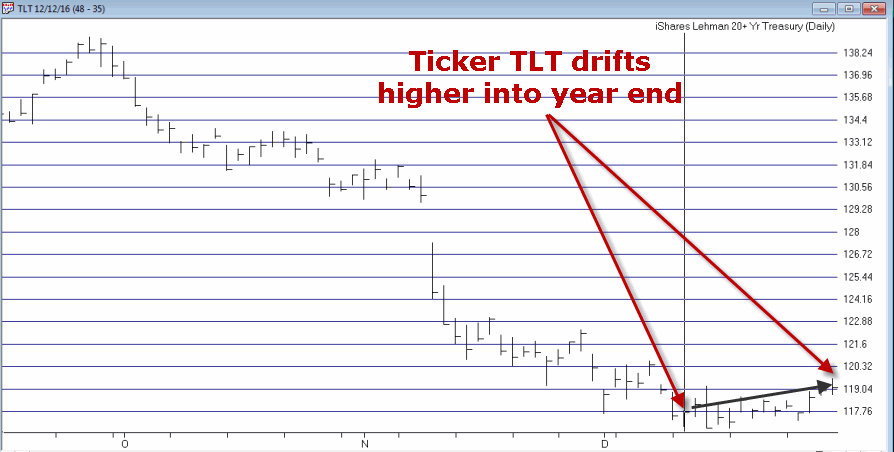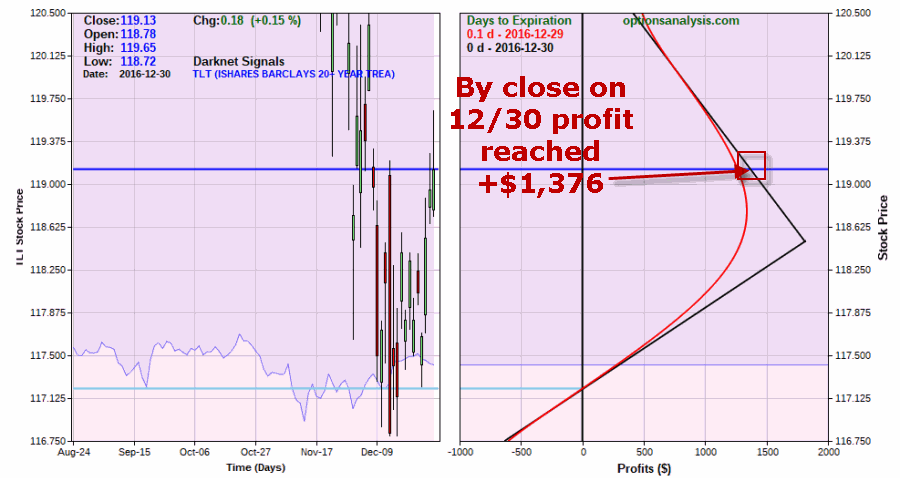This article is targeted for traders who are interested in using options to make money in ways that you cannot simply by buying and selling stocks, bonds, ETFs, commodities, etc. If options “ain’t your cup of tea”, then hey, class dismissed early today! Still, since we are talking about a position that (hypothetically) gained +139% while the underlying security gained all of +1.6%, it may be worth your while to read on.
On 12/12/16 I wrote about a hypothetical trade using options on iShares 20+ Year Treasury Bond (NASDAQ:TLT) – the ETF that tracks the long-term Treasury bond – designed to “pick the bottom” without “betting the ranch.” The strategy is formally referred to as the “2-3-1 Out-of-the-money Butterfly Spread”.
This is the follow up to see how that position turned out.
The Original Trade
*Buy 14 TLT DecQ4 116.5 calls @ 1.96
*Sell 21 TLT DecQ4 118.5 calls @ 0.98
*Buy 7 TLT DecQ4 120.5 calls @ 0.43
The DecQ4 options expire at the close on 12/30/2016
This trade had a cost – and maximum risk – of $987. The maximum profit potential was +$1,813.
With TLT trading at $117.26 a share on 12/12/16 the trade would:
a) Make money if TLT bounces higher between December 12 and the end of the year
b) Lose money if TLT continues to trend lower
Managing The Trade
As I mentioned in the original article this was not a “set it and forget it” trade. A traders actions going forward was very much dependent upon what happens to the price of TLT. Let’s talk first about risk management. At the time the trade was entered:
*TLT shares were trading at $117.26 per share
*The hypothetical maximum risk was -$987, which would be realized if TLT shares were trading at or below $116.50 at the end of the year (when the options expired)
*The breakeven price was $117.21 for TLT shares. The trade would make money with TLT at any price above $117.21.
So how did things work out?
In Review
As you can see in Figure 1, TLT managed to avoid further losses and drifted higher from $117.26 to $119.13 by the close on 12/30/16.
Figure 1: Courtesy AIQ TradingExpert
The position as it appeared during the last day of trading appears in Figure 2 and the risk curves in Figure 3.
The trade could ultimately have been closed out near the close of trading on 12/30/16 for a profit of +$1,376, or +139% on the initial risk of $-987.
Figure 2: Courtesy www.OptionsAnalysis.com
Figure 3: Courtesy www.OptionsAnalysis.com
A technical note for option traders: This trade should be exited prior to the close on 12/30/16 closing all open legs. Here’s why:
Ticker TLT was trading above $119 a share. With a close at that price, if no action was taken by the trader holding this position:
*The 14 long 116.50 calls would automatically be exercised
*The 21 short 118.50 calls would automatically be exercised
*The 7 long 120.5 calls would expire worthless
As a result, a trader who took no action prior to the close would find on 1/3/2017 that there are short 700 shares of TLT (exercising 14 long calls and 21 short calls times 100 shares per option results in -700 shares).
So yes, you do have to know what you are doing (and getting into) when you trade option spreads.
Summary
So what we have in sum is an example of one strategy to consider if you are looking at a security that has been pounded into submission and you:
1. Have a hunch that the “beatings will subside” (at least for awhile)
2. Don’t want to take on tons of risk in hopes of being right
This is one example that just happened to work out. It doesn’t always go that way, which is why planning out in advance what you will do if things go wrong is actually the key to long-term success.



